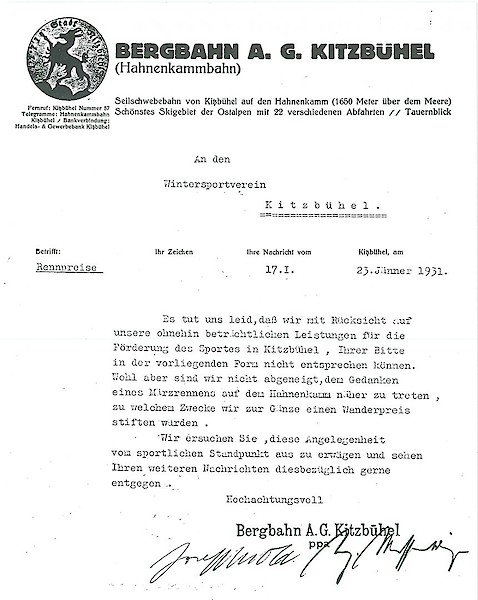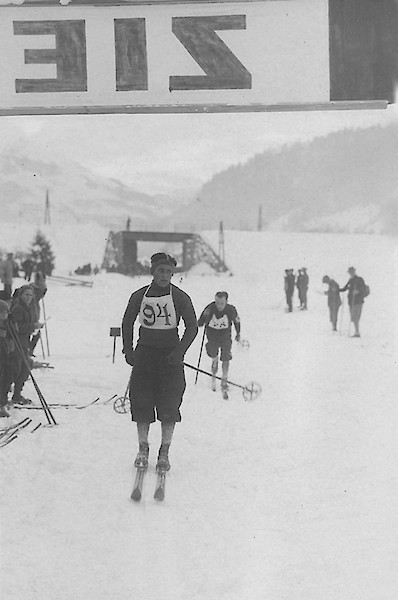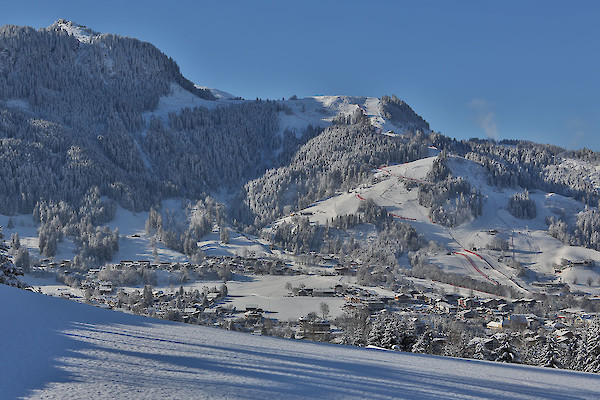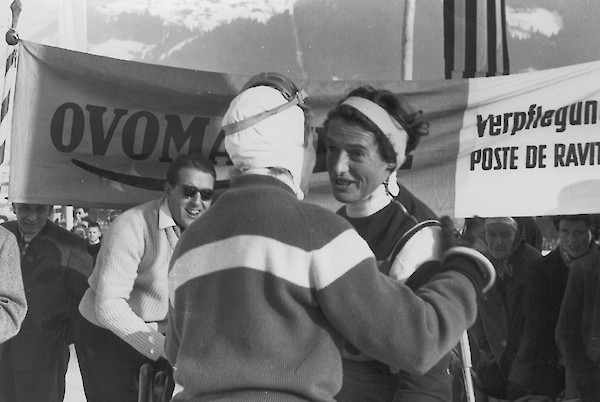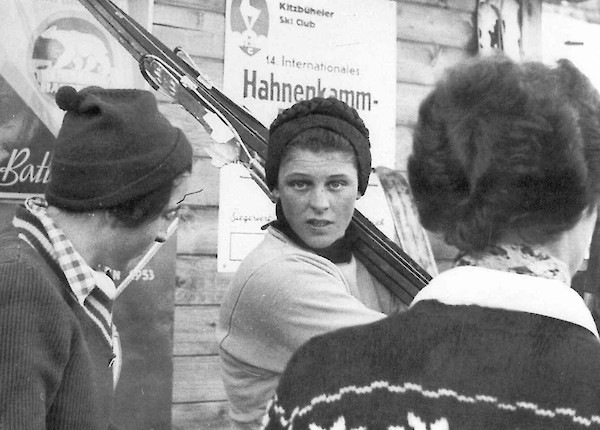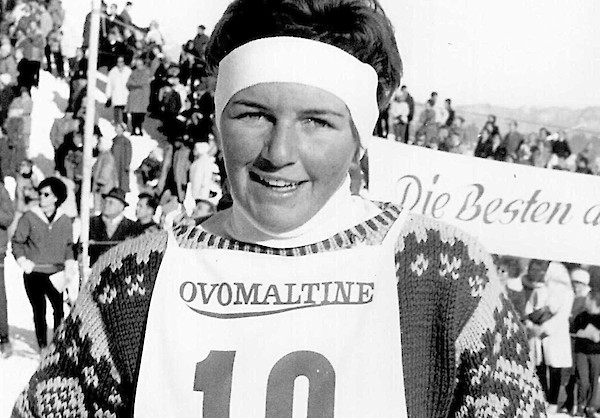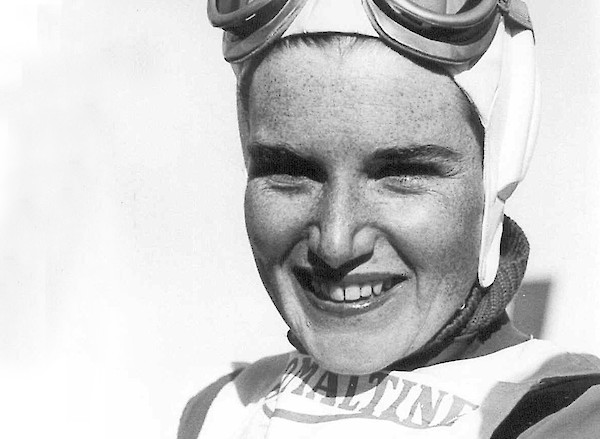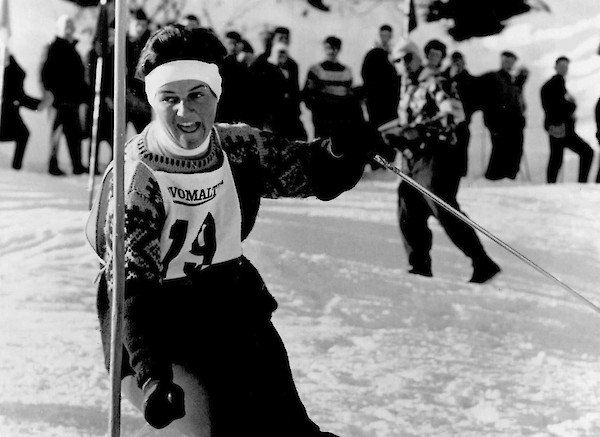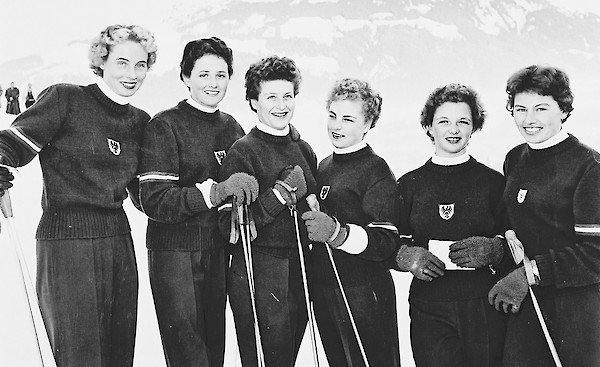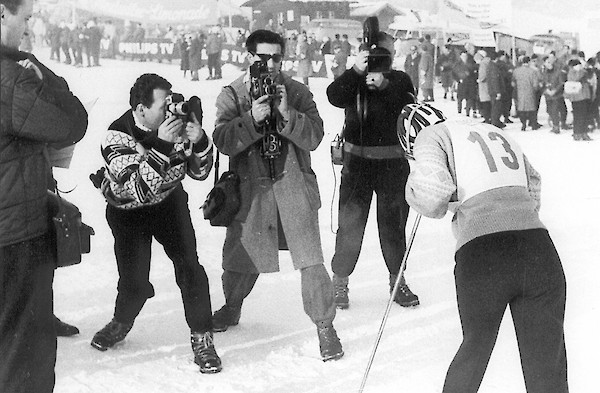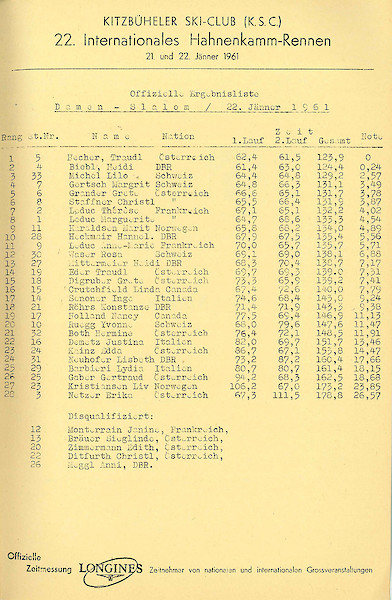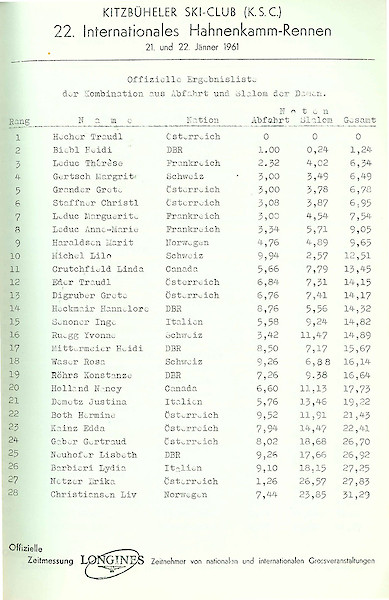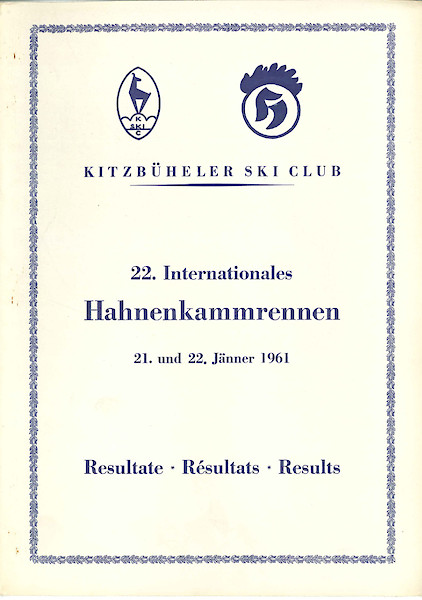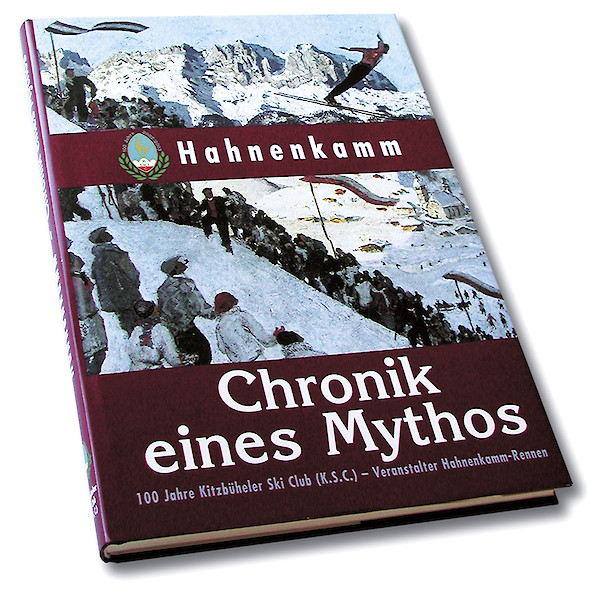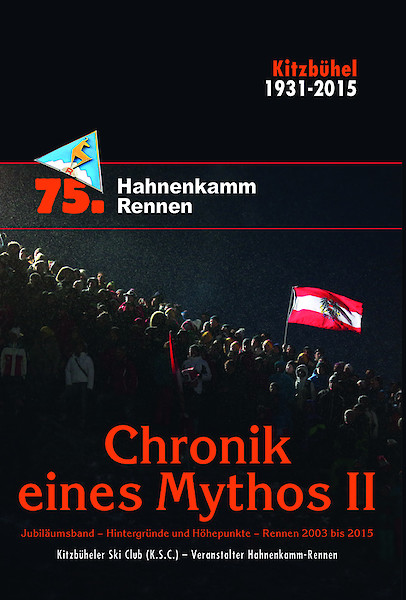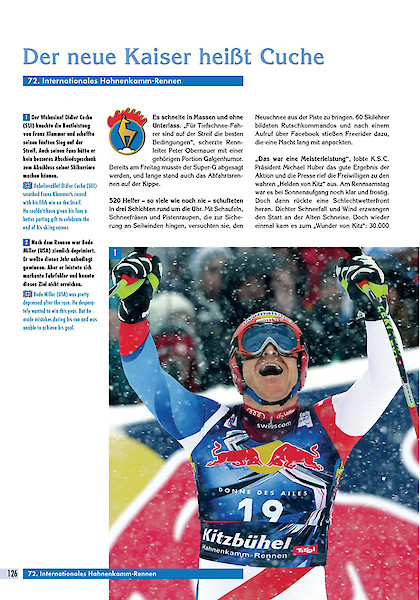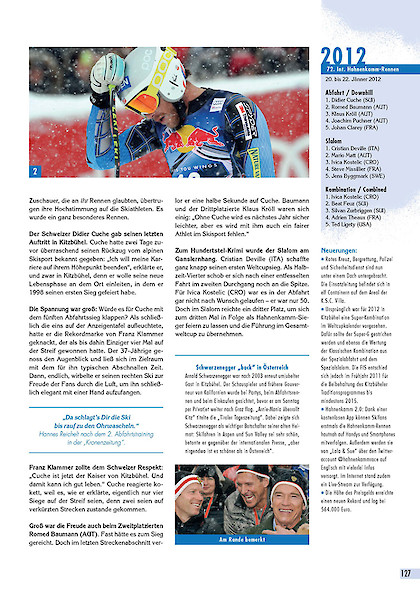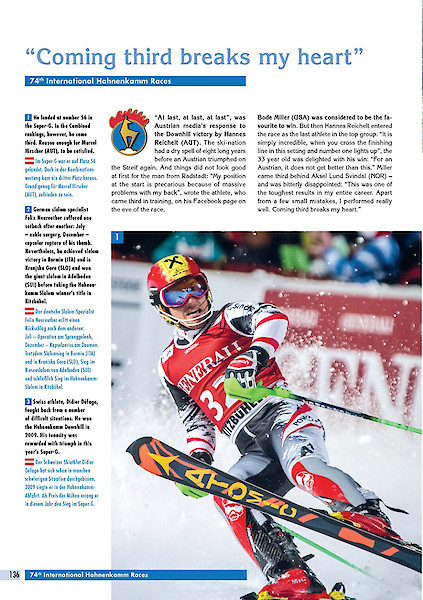The Myth Hahnenkamm
The Silent Birth of a Legend
The Hahnenkamm Race and the Kitzbühel Ski Club belong together like twins. Their histories have run in parallel and have much in common: Christened in the same year (1931) with the same names they bare today, the fruits of deep roots and tradition have formed the building blocks for them both to reach ever higher and achieve ever greater performances. The Ski Club unifies the rich tradition of the Winter Sports Association and the modern Kitzbühel Sport Club with it's ski-squad. The Hahnenkamm race grew from the tradition of the Franz-Reisch-Memorial Race and the fascination with the modern international Kandahar race. When in January 1931 the Franz-Reisch-Memorial Race took place in Kitzbühel shortly after the first officially approved Kandahar event, and in March a competition held by the Winter Association run according to the Kandahar rules had taken place, no-one could have imagined what a success story this combination of the two elements would bring.
This competition on the 28th and 29th of March 1931 was the first Hahnenkamm race. The Winter Sports Association had already turned to the directors of the Hahnenkamm Bergbahn AG in January to ask for their support in putting on the race. They agreed to hold the race in March. This late date was chosen to show the whole world that skiing was still possible on the Hahnenkamm when spring was already blossoming in other renowned winter sports towns. The Bergbahn AG rewarded this advertising effort by donating a challenge trophy.
The organisers and participants of the first race couldn't have known that they were establishing a long term tradition. This wasn't even apparent in the years that followed. The K.S.C only began officially documenting the Hahnenkamm race with the 12th edition in 1950. How the number 12 came about is anyone's guess.
In those days the field was made up of racers who had already taken part in the Mürrener race, as well as competitors from Arlberg and Innsbruck. The Hahnenkamm Bergbahn made the route to the start much easier for the athletes. They only had to go by foot from the mountain station to the start of the downhill at Ehrenbachhöhe. The slalom was originally planned to take place from the Steinbergkogel and go towards Griesalmen. The weather forced a change of course. The first Hahnenkamm race was reported in the Innsbrucker Newspaper as follows: "On Saturday and Sunday the Winter Sports Association of Kitzbühel played host to a competition that was a beautiful sporting event with numerous participants from the Kandahar Ski-Club Mürren. The downhill started from Ehrenbachhöhe, and went via the upper and lower Fleckalpe to Klausen. Perfect corn snow and glorious weather swished the racers to the valley; the times they recorded are amazing for the era. In the morning the weather was poor so the slalom had to be relocated to the valley. In the afternoon the sun finally broke through the clouds and the race directors decided to hold the slalom race on the Hahnenkamm. Bill Braken, the English Skiing Champion and winner of the slalom event in the Kandahar meeting, set a classy slalom course that demanded a lot of technical expertise. A considerable number of spectators followed the exciting race with interest."
26 sportsmen took part in the downhill. Nine competitors finished the course. The winner was Ferdinand Friedensbacher with a time of 4:34.12 minutes. The slalom featured 22 racers, victory going to Hans Mariacher with a time of 0:44.48 minutes in the first run and 0:43.12 minutes in the second run. The English racer Gordon Neil Spencer Cleaver from SC Kandahar placed second with times of 0:42.48 and 0:44.00 minutes. This meant that Cleaver, who had come sixth in the downhill, finished with a rating of 269.29 which gave him combined and overall victory.
© Kitzbüheler Ski Club
Names on the Hahnenkamm
Everyone interested in ski sport and even everyone following the life and parties of the so called "jet set" and VIPs knows what the Hahnenkamm race is. Everyone with a name in society tries not to miss this annual "must see" event in Kitzbühel. But how the Hausberg mountain of Kitzbühel came to be named as it is no one can say for sure.
The first written document using the name "Hahnenkamm" dates way back to 1572, however slightly varied as "Handlkamp". The word "Kampl" is a dialect synonym for a comb. The word "Handl" was hard to understand so soon locals, foreigners, cartographers and topographic engineers interpreted the name as "Hahn", meaning cockerel. This is how the mountain earned the name it still has today. Back in the days when the summit was still covered with trees — and judging by the height it surely must have been — the mountain, with the pine covered mountain tops, really must have resembled the comb of a cockerel. Other experts have tried to explain the peculiar name with a sheer rock face in the upper part of the mountain, which is lined by both a red shimmering stone and numerous lines of pine trees. When looked at from a certain angle this region supposedly looks like the famous cockerel comb. As a final theory, there are some people who are quite sure that the mountain fields on the "Hahnenkamm" used to act as stage for a so called "Hahnenbalz" therefore giving the mountain the name.
The local farmers of the region however used the old name "Halikampl" for years and years. The word "Hali" could be the remnant of the name the mountain was given in pre-Christian times, it may even have some kind of religious undertone. One of the many theories creates a connection between this name and the old Germanic winter "sun festival". Finally one also has to take the old German adjective hâli = "smooth, slippy" into account: Halikampl — smooth, icy mountain?
The Streif is named after the "Streif Alm" and crosses the top section of the downhill race course. The fields themselves probably received their name from a farmer from Westendorf who was called "Straiff". The "Ganslernhang" which hosts the world’s best slalom skiers is simply named after the Gänsbach stream which flows past swiftly near by. The huge farming house that stood there right up to the year 1993 was called Ganslern as well. The "Seidlalm Jump" is named after the "Seidlalm" just below, while the infamous "Hausbergkante" is named after the adjourning properties "Oberhausberg" and "Unterhausberg". While the names "Steilhang" (steep drop), "Brücken and Lärchenschuss" (straight sections) and "Alte Schneise" (old ditch) are easily explained and interpreted, the word "Mausefalle" which describes the first difficult section of the downhill course is a real mystery in itself. The most probable theory is that the name was thought up by skiing legend Toni Sailer Snr. himself, as he once said it reminded him of an old mouse trap.
Women's ski racing at the Hahnenkamm
"We were just as ambitious"
It is a sad fact that since 1962 the ladies races have been removed from the race programme. Male ski heroes without their female counterpart is a little like Superman with no Superwoman and Batman with no Batgirl. But FIS officials a long way from Kitzbühel deemed it necessary and Bad Gastein wanted its own World Cup race. So the inevitable came to pass, despite all the interventions made by K.S.C. Secretary, Captain Leopold Pischl: from 1962 onwards, the women’s races have been held in Bad Gastein.
The future of women at the Hahnenkamm
After weather conditions prevented the women’s races from being held in 1990 and 1998, the subject of “Women at Hahnenkamm” went rather quiet. Technically speaking, competitions with a race course over the Ganslernhang Slope are certainly possible. However, for organizational reasons it would be nigh on impossible to hold the women’s races on the same weekend as the Hahnenkamm men’s races. At present there are no moves being made to bring the women’s races back to Kitzbühel. Not least because organizing the women’s race is associated with a significant financial outlay. So it does not look as if the ladies will be joining the Hahnenkamm start line any time soon. But who knows what the future holds…
Too Dangerous for the Women?
“Women should not take it upon themselves to race like men." This statement may well have come from the early days of ski competition, maybe even from the first few years of the Hahnenkamm race in the 30s. The women who were active in the sport in those days belonged to the upper class. Only "society ladies" had the time and money for this "strange pastime". There were also exceptions who took part in competitions after much hard work and sacrifice. But the female athletes did not receive much public attention and were really only on the sideline of events.
But strangely enough this statement did not come from long ago, but from the German double Olympic winner in 1976 (Innsbruck), Rosi Mittermaier. She said women should not take part in downhill races at the Streif. Even today, she still holds this opinion concerning severe accidents at high speeds: "The women do not need to be more brutal in races than they already are." The discussion around women in ski racing is still very current.
Women's ski sport in Kitzbühel began with much promise. The first female sport pioneer in Kitzbühel was Paula Lamberg who came from a well-established aristocratic family. In the Scandinavian press, she was called the "Soaring Countess". This was written about her in the winter sport yearbook in 1910: "The best female ski jumper in Europe is Countess Paula Lamberg from Kitzbühel. In 1910, the passionate skier was able to successfully land jumps of 24 and 23 meters in excellent form. Jumps of this distance are also outstanding for a man, how much more difficult it must be for a lady with their restrictive clothing." Unfortunately, this outstanding lady of sport suffered an early death. She died in 1927 in the passenger seat of a race car during the Salzburg race while riding with her husband Count Franz Schlick.
The first Hahnenkamm race with female competitors took place in 1932. The winner of the downhill, the slalom and also the combination was Rini Andretta from Kufstein. In 1935, a noble lady from the Netherlands, Baroness Grazia Schimmelpenninck, dominated the women's competitions. She won the combined again in 1936, making her the first woman to win at Hahnenkamm a second time. This wasn't repeated until 1959 when the Norwegian Astrid Sandvik won it for the second time after taking the title for the first time in 1956. That was a sensation. In that year, Sandvik only started training two weeks before the race. The third to be added to the list of two-time winners was Traudl Hecher from Tyrol, winning in 1960 and 1961.
In the years after the war the competitions suffered from the fact that the German participants had to start in a guest class and therefore couldn't officially win at Hahnenkamm. This was because of formal reasons: There was not yet a German ski association that could send representatives to international competitions. This limitation added to the fact that only local female racers won at Hahnenkamm in the 40s. This series was abruptly ended in 1951 by Andy Mead-Lawrence, who had excellent results in the downhill and slalom achieving a combined rating of zero, to become the first female American to win at Hahnenkamm.
In 1953, voices became loud, they said the course was too dangerous for the women. Not without reason: Resi Schafflinger and Heidi Möslacher from Salzburg were injured in training this year. Schafflinger broke her ankle; Möslacher broke her tibia and fibula. In 1954, as the women's course went over Fleckalm — the start was at Ehrenbachhöhe, and the finish was at Klausen — the American club pulled out of the competition. They said the course was too difficult. Then, at the end of the 50s and beginning of the 60s, an American, Penny Pitou, together with Traudl Hecher from Tyrol made headlines. Both were part of a generation that would start a new era for women in winter sports. In 1960, the young athletes were called "ski chicks" by the women's magazine Frauenblatt — Hecher and Pitou were both teenagers. They proved, "that today the weaker sex can also ski elegantly and courageously and are capable of providing sporting sensations", reported Frauenblatt. The magazine attested to this big advantage: "They grew up with a modern, super elegant ski technique." Pitou and other local and foreign racers came to enjoy working in the ski manufacturing company owned by Anton Kästle. That way they could make it through a winters skiing without income. The American acquired technical knowledge and even learned the Tyrol dialect thanks to her friendship with Egon Zimmermann I.
Kitzbühel and its traditional ski club could no longer profit from this turn of events. Disputes at the green table ended the FIS women's race for Kitzbühel. Officials from Badgastein had successfully lobbied to finally be allowed to have a FIS race of their own. Outside of Tyrol, it seemed that the women's race was too much for the Kitzbühel Ski Club; it would exist in the shadows in comparison to the men's race. Back then it was not possible for the Austrian ski association to apply for a second international race in the same category. All attempts by the K.S.C. secretary, Captain Leopold Pischl, to keep the women's race from moving to Badgastein were unsuccessful. The recommendation of the Italian ski association to couple the Austrian race dates with the Italian race dates was the final straw. The women started for the last time at the 23rd Hahnenkamm race in 1961.
Since then, women's races in Kitzbühel were not a topic of interest for nearly 30 years. In 1990, thought was given to allowing the women to take part in the Hahnenkamm race again, as the K.S.C. planned a women's Super-G on the occasion of the 50th Hahnenkamm race. On the women's course, there was an up to seven metre wide lane that was to be raced through at about 100 kilometres an hour. But difficult weather conditions even placed the men's race in question. The head trainer for the German women's teams, Günter Hujara thought it's impossible to run the course through this bottleneck. The race was therefore cancelled by the TD present and the jury. The last attempt to reinstate the women's race failed in 1998, once again because of bad weather. Rosi Mittermaier's introductory quote are a comfort for many competitors. Mittermaier could do without "this hell ride" (Die Welt) and stated: "I was never jealous of the men and their Kitzbühel race, not at all."
© Kitzbüheler Ski Club
Reference: "Chronik eines Mythos"
Reference Books Hahnenkamm-Races
"Chronicle of a Myth" - issue 1
In celebration of th 100th anniversary of Kitzbüheler Ski Club (K.S.C.), "Chronicle of a Myth" was published in December 2002. The 100 year history of the K.S.C. was recorded in the first edition.
Interesting stories, such as Kitzbühel’s application to host the Alpine Ski World Cup in 1970 or the start at Steinbergkogel, can be found in the 241-page compendium, as well as an abundance of well-prepared statistics. Rolls of honour for winners and runners-up as well as stunning photos from previous years and images from the races up to 2002 make the „Chronicle of a Myth“ an indispensable reference tool that should be on everyone’s bookshelf. The book was awarded with the “ULLR Award” in the USA in 2011.
- 240 page illustrated book
- embossed cover with dust jacket
- thread binding
- 30 cm high, 21 cm wide
- 4 colour offset print
NOTE! The Chronicle of a Myth Volume 1 is not in perfect condition due to the misprint (pages are stuck together or there is minor damage from opening the pages).
"Chronicle of a Myth" - issue 2
75 Mildestones in Kitzbühel's History
Finally. The Hahnenkamm Chronicle has been brought up to date. „Chronicle of a Myth II“ is now available from K.S.C. This book tells the story of the Hahnenkamm Races in chronological order from 2003 to 2015 in German and English. It also includes many topics that were not covered in the first edition.
A great present for ski fans, family, friends and visitors!
It is more than a written description of an annual sporting event. Tens of thousands of sports fans are mesmerized by the Hahnenkamm Races every year. It is more than a chronological listing of past and present sporting achievements, collection of anecdotes and annual particularities. The second edition also documents the Hahnenkamm Races and focusses on the events from 2003 to 2015 – with a detailed expose of the individual disciplines.
Triumphs and tragedies occur year after year at the Hahnenkamm Races, where the international ski elite, well-known personalities from all walks of public life and many thousands of fans meet annually to share in this great sporting adventure with their ski idols. The story of the Hahnenkamm Races is continued in the „Chronicle of a Myth II“. Many aspects and details on the races, their organization, technology and the race courses are included that were only briefly mentioned in the first book „Chronicle of a Myth“ (published 2002), or have since developed into new traditions: each of the 75 Hahnenkamm Races from 1931 to 2015 is a milestone in ski history.
- 160 page illustrated book
- Embossed cover with dust jacket
- Thread binding
- 30 cm high, 21 cm wide
- 4 colour offset print
- Language: German / English
Set-Price (Chronicle of a Myth 1 & 2): Euro 20.- Shipping costs: according to standard postal rate
Order direct: Kitzbüheler Ski Club (K.S.C.), Phone +43 5356 62301 18 or by Mail

